With credits that include Fallout 2, the Icewind Dale series and Neverwinter Nights 2, Tim Donley’s resume reads like an RPG best-of list. And one of his titles in particular has actually topped those lists pretty regularly: Black Isle Studios’ Planescape: Torement. Here, Tim talks about his work on this legendary narrative-driven role-playing game.
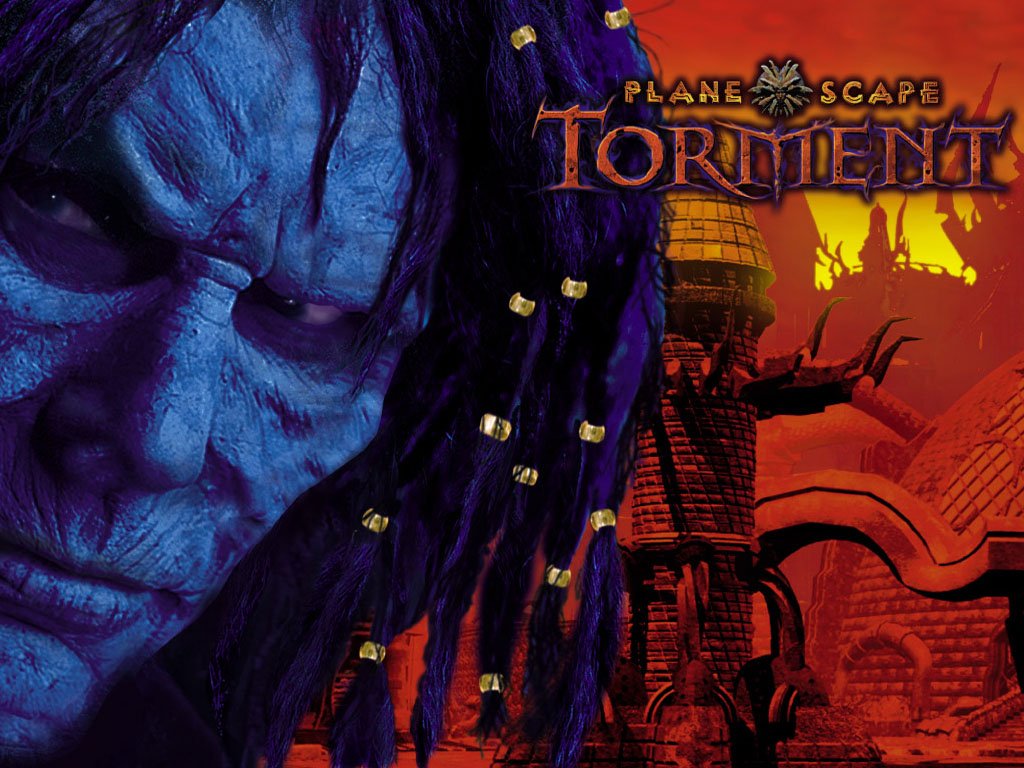
Tim, thanks for taking the time to talk! Maybe you can kick this off by describing how you got started on the project?
Tim: Well, I was hired at Interplay as a cinematic artist and did in-game cinematics for Shattered Steel. This was back before they were called Black Isle, but it did set up the foundation. Feargus (Urquhart) wanted high quality work but he was really open to how we got there. He was the kind of guy who would say ‘here’s a vision, now just head for that mountain, and if you get to the top of the mountain I’ll be happy – whatever means you need to take to get there, just do it’. It was a great experience because it led the way to working on a bunch of other games, including Planescape: Torment, and set the parameters for what the methodology of Black Isle was.
So one thing to point out is that Planescape was originally never going to be the main game we were working on. It was more a thing of ‘let’s get some guys and they can work on this game and we’ll see what happens’. Fallout 2 was coming out and there were so many people working on that, and it was never like Planescape was a big deal. It was more like [Time imitates Feargus]: “just grab Donnelly and Avellone and a few other guys and just get that thing going, whatever the hell’s going on over there!”
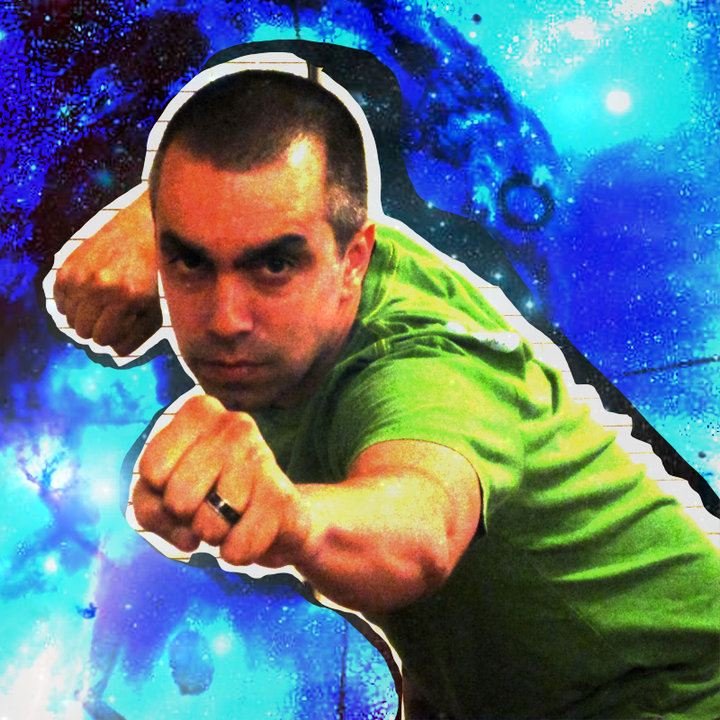
Tim Donley - always the artist.
You’re talking about Chris Avellone, Lead Designer on Planescape: Torment, who wrote the narrative in the game?
Tim: Yep. So I read what Chris had written – and it was amazing. He did a little pitch about it, he introduced me to Sigil and the idea of the Planescape universe, and I got into it. I saw what he was doing with it. Chris had a very big passion for the game and the license.
He was a very open and easy to talk to guy, and really OK with suggestions to change his ideas. I think it would have killed the project if Chris had been a totalitarian visionary and insisted like, “I want the Lady of Pain to have fifteen spikes on her head, no more no less, and I can’t have anything else.” No, he was really about explaining the idea and what he was going for, and it made it so easy to work with him. The team loved it and we all just had a lot of fun.
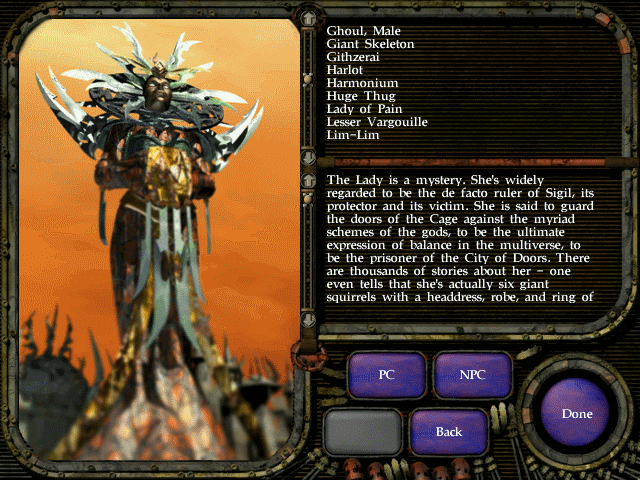
The Lady of Pain
And in terms of taking his character ideas and bringing them to life in the game, was that what you were doing?
Tim: Well, we had this guy, Eric Camponella, who had come over as a concept artist to help us decide what the characters were going to look like. We had a couple people on the project who were initial modellers and animators, and the thing is… now, Eric is probably one of the best character modellers and animators I’ve ever met, but when I first saw his concepts I was like, “these aren’t that good”. His concepts were squiggly and some of the concept modellers were saying how it was really difficult to model them, and then Eric saw the finished product, he said “these haven’t been translated that well”, so I had to laugh and say “well Eric those concepts have been translated about as well as it’s gonna get, so I don’t know what to tell you buddy!”. So he said “give me a shot, I am gonna do this and I’ll show you what’s up” and he dove into it. He’d never modelled a character before, and it was like somebody had just said ‘hey, why don’t we let Michelangelo try make a sculpture!’ because he was just producing these masterpieces that looked nothing like what he’d drawn (laughs). Who cares what it looked like on paper, because the actual, final thing that he made was incredible. It was so good – we would spend so long opening his models and couldn’t understand how he’d built them so well!
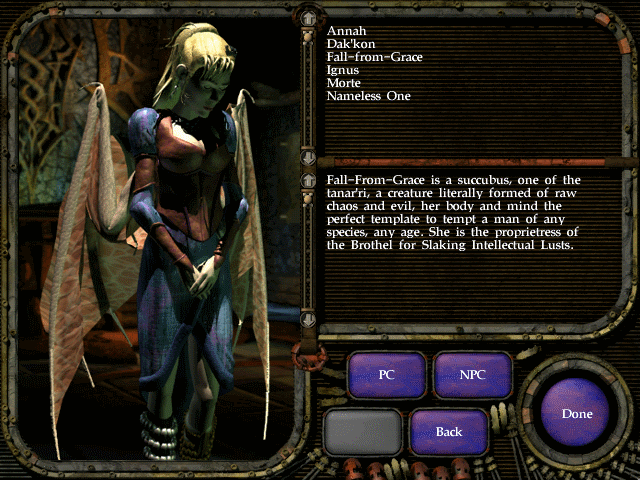
Fall-from-Grace
So he modelled characters, animated them in 3D and then we made sprites out of them. And he was fast, like he could knock out like 3-5 a week. They weren’t low res either - they were hi-res – I mean, the character portraits you see in the game all come from those models. When you see a poster or something, those were the characters he modelled, and basically we’d just use them in the game as a tiny sprite! I think when he started doing the character models it all just came together because he, in one fell swoop, unified the look of the game.
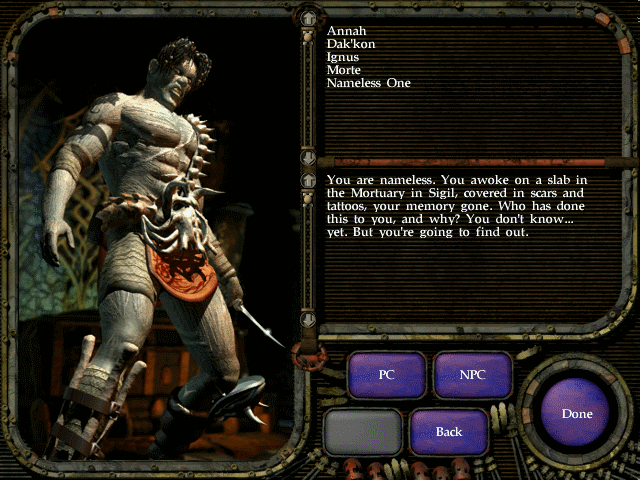
The Nameless One
He did the Nameless One and then everything from that point forwards was an exercise in genius. He just did these incredible models where you’d see Fall From Grace or Nordrom and you’re just blown away by how he figured it all out. It was one of those risks that you take sometimes – someone comes to you with a passionate idea that they’ve never been able to do before, and it sounds very cliché’d to say it because there’s a million movies out there where they go ‘oh he can’t do it, he’s crazy, he’s insane, you can’t make a time machine!’ and then he goes and creates the time machine and everything’s great! (laughs) And Eric was one of those stories where no one thought he could do it. But Eric believed in himself and he was willing to put in the time to prove it, and he did. It really helped us and really motivated the team while we were working through and trying to figure things out. So Eric just nuked it and it raised everyone else’s game.
Wow, sounds awesome. So once you had the pitch and the characters, where to from there?
Tim: So the Mortuary was originally actually going to be a standalone demo – that’s why it’s so big. There’s three giant stories and it’s a forty-minute experience. One day Chris and I went into the main room at Interplay with big sheets of butcher paper and we basically started drawing out the game and we took all the levels together and just drew a map of the whole game, and it was all done in an isometric, Google Maps sort of view, showing how all the areas connected. It was just enormous, I mean, there’s hundreds of screens in the game and we must have done at least fifty drawings of this thing.
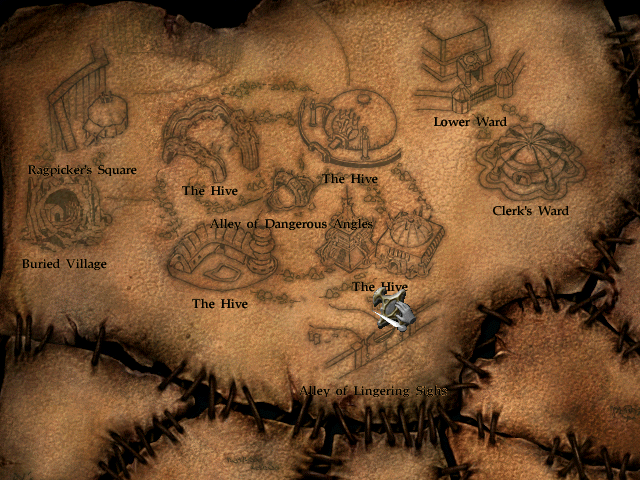
Sigil - a most unique locale
And that was the game – from that point forward we knew what all the levels were going to look like in terms of how they related to each other and their general size, and at that point it really became sort of ‘color in the pages’. I mean, we had the outline and now we just needed to fill it in. That was when the game really started and we sat down and looked around for artists.
It was myself, Aaron Myers, Dan Spitzley and Chris Avellone, we all shared a room and the room was the smallest office – I kid you not, they would not even put prisoners in a room that size! It was probably 2 metres by 4 metres, if that! But it was the most fun I’d ever had! It was just pure adrenalin – we’d get in there at 10 in the morning and wouldn’t leave until 10 at night, and we were just laughing and making the game all day.
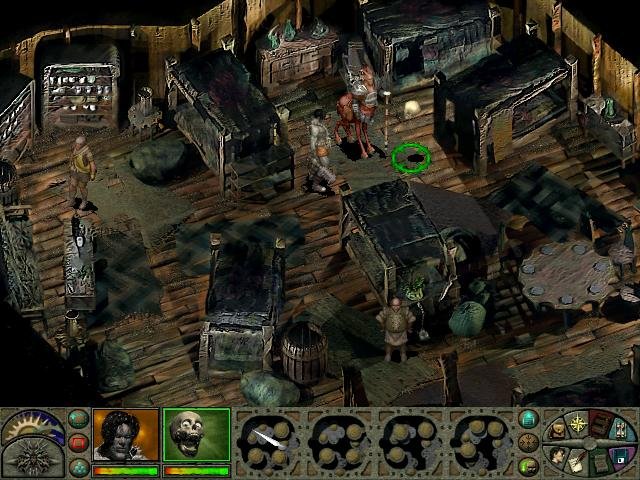
The flophouse - as good as it sounds
So we had the outline of the game and started working on it, and didn’t know how we were actually going to do it. I get a lot of questions about the architecture of the game and how it all came together. These were the days… you know computers… Moore’s law, doubling every two years and all that. The average render took 40 hours to do! So one of those maps, like the Mortuary, took 20-40 hours to render it out. And then you had to go in and touch it up, put in all the doors – it was ridiculous. But we had it down to a routine. I think the biggest thing is that we were picking a direction and we would just stick to it. We really didn’t second guess things. Once it was in and we felt the methodology was solid, we almost never changed the methodology. We were just like “no, no, no, once it’s in and it works, don’t fuck with it, just make it happen”.
Well it obviously worked, as you can tell from the reception and the fact we’re still talking about it so many years on. Were there any major challenges that came up while you made the game?
Tim: Planescape really tried to do a lot. It tried to be a lot of things to a lot of people, and what the team did with that engine, well, BioWare never expected us to do that. The Infinity Engine wasn’t meant for that type of a game. It wasn’t made for 800,000 words of text! It was made for Baldur’s Gate and they designed it all around Baldur’s Gate and its needs as a D&D game. With Torment, we didn’t want all of that stuff. The Nameless One basically has infinite stats and he’s going to get even more stats, so we couldn’t user their interface directly. We had to modify it because we had weird items that modified weird things.
I mean, Planescape, if you’re familiar with it, its whole point is that it’s wacky. Everything’s wacky! Nothing is what you expect. Like, you pick up a sword and it can talk to you, and now suddenly you’ve got to have a sword character, and Bioware didn’t expect this and so the Infinity Engine is not really made for that. We modified it where we could and where we couldn’t, we worked around it. You know, the Infinity Engine is amazing and the fact that they made it at the time is just unbelievable.
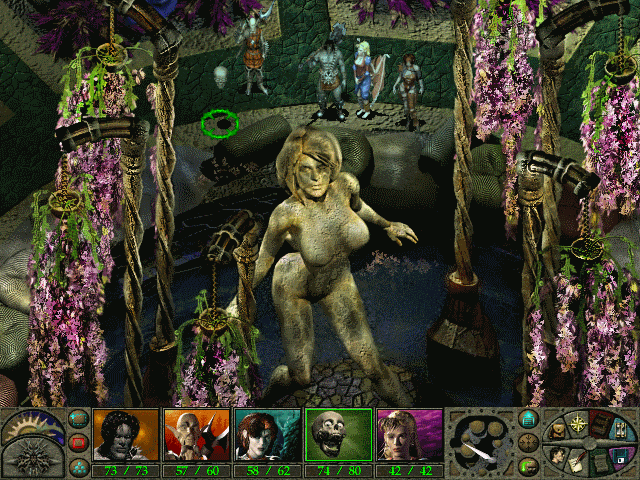
The Brothel for Slaking Intellectual Lusts
So you guys had been working on Fallout 1 and 2 as well – why adapt the Infinity Engine rather than adapt Fallout’s engine?
Tim: Undoubtedly, during development there was thinking that Planescape overall was closer to Baldur’s Gate than it was to Fallout 2, and I do think that’s the case. You look at them and on the surface level they look very similar, but Baldur’s Gate’s real time element was something that Fallout’s engine didn’t do, and that was a big deal and something everybody really liked. So, like an RTS you could click around and go places, whereas Fallout you had to make a move, stop, think, make a move, stop. That isn’t how people wanted to play Baldur’s Gate or Planescape: Torment at the time. In fact, come to mention the Fallout games, we did have people being pulled off Planescape to finish Fallout 1, and then we lost some designers who helped finish off Fallout 2.
How was it working after that, as the game would have been pretty far along by this time, surely?
Tim: So we lost a few guys and I was drinking a litre or two of Mountain Dew a day going crazy finishing this thing off, because we could see the end in sight. We were way down the line and every artist is super focused, but as development started winding down I began playing it. And this is when I knew. I can remember the specific day when I knew it was going to be good. We’d put together enough of the game to the point where you could play it for maybe the first 5, 10 or 20 hours, whatever it was, and you were playing the actual game for reals.
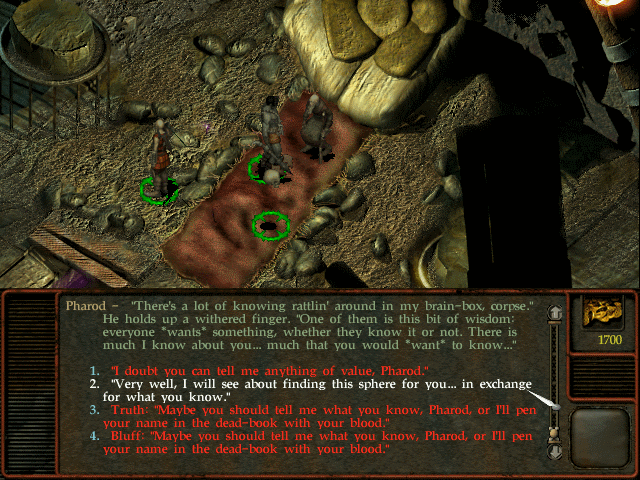
Pharod... and his mysteries
Now, I had been head down in the game for two years, and I hadn’t been able to follow things and seen how they all fitted together. I’d seen the character models, I’d seen the levels and done some of the animations, but when I sat down and started the Mortuary and finished that and got out into the town and you hear “over here, cutter!” and just thought this game’s amazing! This city’s great! Because now it was populated with people and I’d only been seeing it as an image. And I’m running around and doing all this stuff, and I pick up Annah and at one point I get down to Annah’s father and the whole story about Pharod. So even though I’d worked on that, it was still a shock that that’s your dad. I was 100% surprised and didn’t know how they slipped that twist in there!
For sure - Chris Avellone famously worked some serious magic into the writing of Planescape: Torment.
Tim: Yeah - Chris had this story and I had no idea until then that the game was that good. I had no idea there were all these interconnections and twists and turns. I mean, I was surprised by the game, and I was working on it! So other people were definitely going to be surprised by it. I remember thinking, “this is seriously amazing”. It was one of those things where I just thought that this game is really, really good. You don’t really know at the time where things could go when you’re working on something like this.
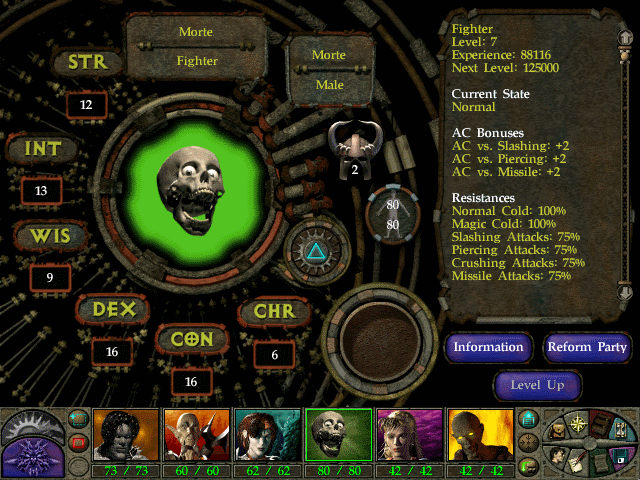
Morte's character sheet. Remember: "Don't trust the skull..."
It sounds like you really had a blast working on the game?
Tim: It really was a ton of fun. We worked a lot of hours, but it was also flexible as long as you got the stuff done… we were also encouraged to be humourous and do fun stuff, and just put in things we thought were fun. Chris never censured that sort of stuff and gave us a real organic run with the art, and his attitude was basically, “do the best you can with the time you have”. It really cuts out a lot of the BS when the team likes each other. There’s a lot less time spent on discussing things, so by the end we were working so quick and so fast because we knew each other so well. We didn’t have to spend too much time in meetings, we just worked!
We didn’t have to always ship concept art or record some meeting about designing a house – none of that mattered. What mattered is what gets into the code and ships. We probably did 4 years’ worth of work in 2 and a half! It was a lot of fun but we worked our rear ends off. (laughs)
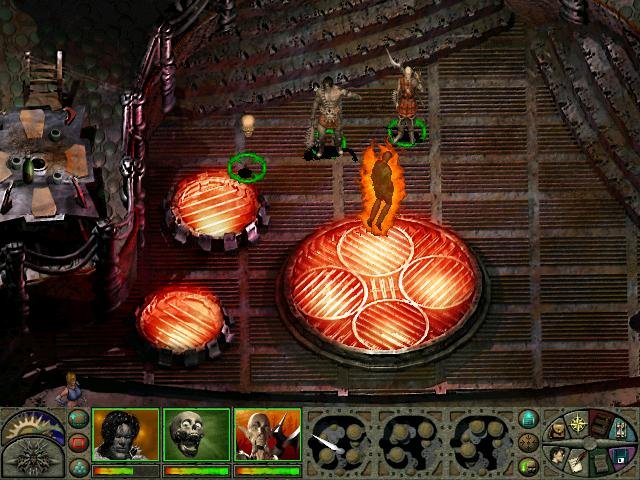
The Smoldering Corpse Bar, where we met Ignus
So Planescape: Torment set the pace, and Icewind Dale was actually a lot less work after that. It was more of a dungeon crawler, and we benefitted from switching from Lightwave to 3D Studio Max. Everything we learned in Planescape we applied to IWD – and we had learned a lot, so itook a lot less time.
Oh and one story I remembered – I had to help do some work on Fallout 2, so I had to design the ornithopter [Now referred to as the vertibird]. They needed this helicopter-like thing, so I built the model for that, and another artist did the ‘broken’ versions and final textures. And that small project then becomes the main helicopters in Bethesda’s Fallout 3, and it was something I did in my lunchtime! Now you see them all over the place, and I just threw the design together at the height of being in the zone for Planescape!
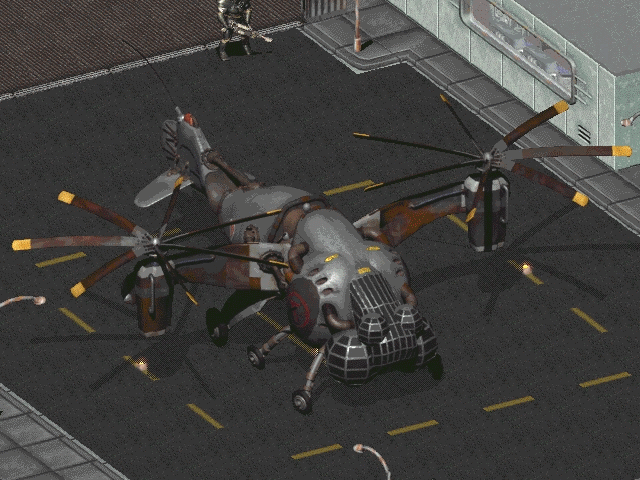
One of Tim Donley's little lunchtime projects...
Hah, that’s great. They’re such a big part of Fallout 4 as well – crazy that it was a side project that emerged while you were working on Planescape!
Tim: Yeah, it’s cool when so many years later you see this echo of something you’ve done.
In closing: you’ve already said how you realized towards the end of development that you were working on a special game. But did you know have any idea it would go on to be the legendary and influential title it is today, almost twenty years later?
Tim: I do feel like at the time we did sense that something good was going to come out of it. There was definitely that. There were these moments where we saw the game through Bioware’s eyes, or through other people’s eyes, and we felt like this could actually do something and go somewhere. I don’t think we thought that far into the future, like oh it’s going to be a classic or anything like that, but I feel we did have something special. I don’t think anyone really thought it was going to be that big at the time. We just did the best we could and it made a big difference. We managed to keep the quality bar on the game really high despite losing people. It was really tough, but we never lost the backbone of the game – whenever someone left we managed to stay on target for the game.
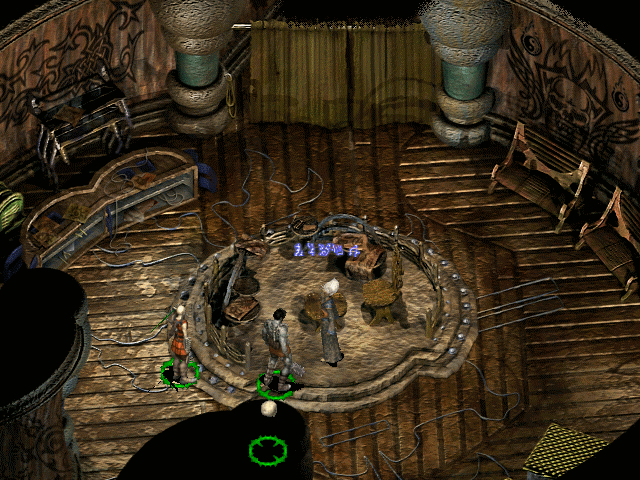
The strange language of the Fell
Planescape: Torment was and still is one of my top development stories, if not the top. It’s just a great story. It was a super fun project. Overall, a big thing was that Chris really let me be me, too, which was great, and it really allowed me to work in a development environment I really enjoyed. Ever since then, that’s sort of been my template for a development environment. The Torment team was so good and we were so synergised that I really look to duplicate that feeling in all the teams I work on. It’s been part of my success – I really feel I owe a lot to guys like Chris and Feargus and the team in general for accepting my ideas and accepting the concepts I brought to the table as much as they did the art itself.
You know, there were philosophies there that I wanted to try out and they were encouraging of it and that was great. It really helped, and it made the game. If you asked me why Torment was so good, I think it was because the team was so good and so motivated, and if you ask me why they were so motivated I would say it was because we had a freer working environment than normal. We really had a very open environment, you figured it out and learn what you needed to get it done, and everyone had their place, so it was really helpful.
Excellent. Thanks a lot, Tim, I really appreciate you taking the time to do this interview.
Tim: It was awesome. Have a good night!
Donley Time Foundation is currently working on the indie title Boss 101, which Tim and I discuss at length in a forthcoming interview. You can learn more about this upcoming action adventure shoot-em-up on Steam, or follow their regularly-posted developer updates here.
Beamdog, who remastered Icewind Dale and the Baldur's Gate series, have recently released Planescape Torment: Enhanced Edition. Find out more from gog.com.
Previous:
Interesting People #3: Robyn Miller on filmmaking, character writing, videogames and more
Next:
Interesting People #5: Joel Manners, Lead Designer on Wing Commander: Privateer
